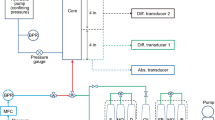Abstract
Low-tension gas (LTG) flooding is a promising chemical enhanced oil recovery technique in tight sandstone and carbonate reservoirs where polymer may not be used because of plugging and degradation issues. This process has been the subject of many experimental studies. However, theoretical investigation of the LTG process is scarce in the literature. Hence, in this study, we lay out a displacement theory for LTG flooding, with a constant mobility reduction factor, which lays the groundwork for further theoretical studies. The proposed model is based on the three-phase flow of water, oil, and gas in the presence of a water-soluble surfactant component. Under the developed model, we study the effect of MRF and oil viscosity on the flow dynamics and oil recovery. Moreover, we explain experimental observations on early gas breakthrough that occurs during LTG core floods even in the presence of a stable foam drive.







Similar content being viewed by others
Notes
Reservoir simulators generate saturation versus distance. To be able to compare the results from the simulator to our model, we have to convert distance to wave speed or vice versa. For consistency, we decided to convert distance to wave speed. We obtained wave speed for a profile at a particular pore volume, \(t_D\), using the relation: wave speed \(= x_D/t_D = x/Lt_D\). The length of our core is 100 \(\mathrm {ft}\), and we used saturation profiles at 0.1 PVs; hence the scaling relation between wave speed and distance is: wave speed \(= x/(100\times 0.1) = x/10\). Had we used profiles at 0.2 PVs, the scaling relation would be wave speed \(= x/20\).
Note that some of the relative permeability parameters in the first phase environment are different from their counterparts in the second phase environment.
References
Al-Saedi, H.N., Flori, R.E., Al-Jaberi, S.K., Al-Bazzaz, W.: Low-salinity water, co 2, alkaline, and surfactant EOR methods applied to heavy oil in sandstone cores. SPE J. (2020)
Barrios Molano, H.E., Sepehrnoori, K.: Development of a framework for parallel reservoir simulation. Int. J. High Perform. Comput. Appl. 33(4), 632–650 (2019)
Das, A., Nguyen, N., Nguyen, Q.P.: Low tension gas flooding for secondary oil recovery in low-permeability, high-salinity reservoirs. Fuel 264(116), 601 (2020)
De Souza, A.J.: Wave structure for a nonstrictly hyperbolic system of three conservation laws. Math. Comput. Model. 22(9), 1–29 (1995)
Denney, D.: Systematic study of Alkaline/surfactant/gas injection for EOR. J. Petrol. Technol. 62(01), 42–43 (2010)
Fernandes, B.R.B., Marcondes, F., Sepehrnoori, K.: Development of a fully implicit approach with intensive variables for compositional reservoir simulation. J. Petrol. Sci. Eng. 169, 317–336 (2018)
Haddad, M., Sepehrnoori, K.: Development and validation of an explicitly coupled geomechanics module for a compositional reservoir simulator. J. Petrol. Sci. Eng. 100(149), 281–291 (2017)
Hosseini-Nasab, S., Zitha, P.: Investigation of chemical-foam design as a novel approach toward immiscible foam flooding for enhanced oil recovery. Energy Fuels 31(10), 10525–10534 (2017)
Janssen, M.T., Mutawa, A.S., Pilus, R.M., Zitha, P.L.: Foam-assisted chemical flooding for enhanced oil recovery: effects of slug salinity and drive foam strength. Energy Fuels 33(6), 4951–4963 (2019)
Janssen, M.T., Pilus, R.M., Zitha, P.L.: A comparative study of gas flooding and foam-assisted chemical flooding in Bentheimer sandstones. Transp. Porous Media 131(1), 101–134 (2020)
Kang, W., Liu, S., Meng, L.W., Cao, D., Fan, H.: A novel ultra-low interfacial tension foam flooding agent to enhance heavy oil recovery. In: SPE Improved Oil Recovery Symposium, Society of Petroleum Engineers (2010)
Le, V.Q., Nguyen, Q.P., Sanders, A.: A novel foam concept with co2 dissolved surfactants. In: SPE Symposium on Improved Oil Recovery, Society of Petroleum Engineers (2008)
Mehrabi, M., Sepehrnoori, K., Delshad, M.: Solution construction to a class of Riemann problems of multiphase flow in porous media. Transp. Porous Media 132(1), 241–266 (2020)
Phukan, R., Gogoi, S.B., Tiwari, P.: Alkaline-surfactant-alternated-gas/co2 flooding: effects of key parameters. J. Petrol. Sci. Eng. 173, 547–557 (2019)
Phukan, R., Gogoi, S.B., Tiwari, P.: Enhanced oil recovery by alkaline-surfactant-alternated-gas/co 2 flooding. J. Pet. Explor. Prod. Technol. 9(1), 247–260 (2019)
Ren, G., Zhang, H., Nguyen, Q.: Effect of surfactant partitioning on mobility control during carbon-dioxide flooding. SPE J. 18(04), 752–765 (2013)
Sanaei, A., Varavei, A., Sepehrnoori, K.: Mechanistic modeling of carbonated waterflooding. J. Petrol. Sci. Eng. 178, 863–877 (2019)
Srivastava M, Zhang J, Nguyen QP, Pope GA (2009) A systematic study of alkali surfactant gas injection as an enhanced oil recovery technique. In: SPE Annual Technical Conference and Exhibition, Society of Petroleum Engineers
Szlendak, S.M., Nguyen, N.M., Nguyen, Q.P.: Laboratory investigation of low-tension-gas flooding for improved oil recovery in tight formations. SPE J. 18(05), 851–866 (2013)
Wang D, Cheng J, Qun L, Wu J, Wu W, Zhang Y (2001) First ultra-low interfacial tension foam flood field test is successful. In: SPE Annual Technical Conference and Exhibition, Society of Petroleum Engineers
Wang, J., Ge, J., Zhang, G., Ding, B., Zhang, L., Jin, L.: Low gas-liquid ratio foam flooding for conventional heavy oil. Pet. Sci. 8(3), 335–344 (2011)
Wei, W., Varavei, A., Sanaei, A., Sepehrnoori, K., et al.: Geochemical modeling of wormhole propagation in carbonate acidizing considering mineralogy heterogeneity. SPE J. 24(05), 2–163 (2019)
Acknowledgements
We highly appreciate Dr. Mahdi Haddad at the Bureau of Economic Geology, Jackson School of Geosciences, at The University of Texas at Austin for the meticulous technical and verbal edition of this manuscript.
Funding
The authors have not disclosed any funding.
Author information
Authors and Affiliations
Corresponding author
Ethics declarations
Competing interest
The authors have not disclosed any competing interests.
Additional information
Publisher's Note
Springer Nature remains neutral with regard to jurisdictional claims in published maps and institutional affiliations.
Rights and permissions
About this article
Cite this article
Mehrabi, M., Sepehrnoori, K. & Delshad, M. Displacement Theory of Low-Tension Gas Flooding. Transp Porous Med 142, 475–491 (2022). https://doi.org/10.1007/s11242-022-01753-z
Received:
Accepted:
Published:
Issue Date:
DOI: https://doi.org/10.1007/s11242-022-01753-z




